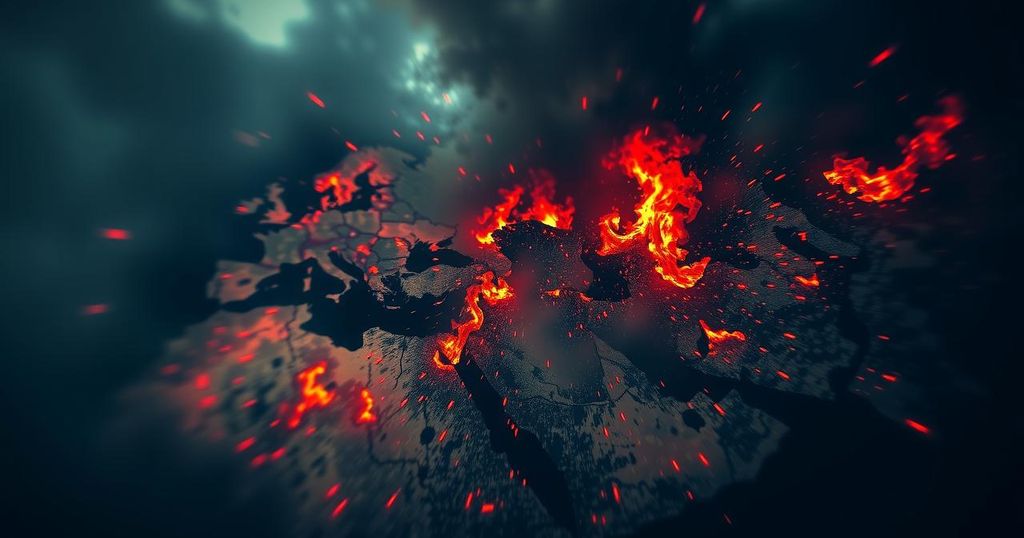Hezbollah and Hamas: Resilience Amidst Israeli Military Actions

Recent U.S. intelligence assessments indicate that while Israeli military actions have significantly diminished Hezbollah and Hamas’s capabilities, both groups remain resilient. Hamas’s recent adaptations toward insurgency and increasing recruitment highlight their ongoing threat. Additionally, escalating civilian casualties raise concerns regarding a subsequent emergence of terrorism globally, particularly from affiliates like ISIS and al-Qaida. A comprehensive, adaptive counterterrorism strategy is essential to mitigate these threats.
Recent assessments by a senior U.S. counterterrorism official highlight that while Israel’s military actions against Hezbollah and Hamas have inflicted substantial damage, they have failed to incapacitate either group. Brett Holmgren, Acting Director of the U.S. National Counterterrorism Center, stated that both organizations remain resilient. Although Israeli operations have significantly reduced their immediate threat to Israel, Hezbollah’s extensive arsenal and operational capacity still pose considerable challenges. Hamas, having suffered losses after instigating the conflict on October 7, continues to demonstrate recruitment capabilities, adapting to an insurgent-style warfare approach. Furthermore, the substantial civilian casualties in Gaza and Lebanon raise concerns regarding the potential for a resurgence of terrorism linked to various extremist groups. \n\nHolmgren emphasized the global repercussions of the conflict, as it appears to have revitalized movements affiliated with ISIS and al-Qaida. In Africa, the rise of extremist activities is notable, particularly as operational environments degrade due to political instability. The United States remains vigilant, tracking Iran’s influence and interventions, particularly concerning its connections to Hezbollah and Hamas. Furthermore, the emergence of younger individuals in terrorist organizations reflects a worrying trend exacerbated by the ongoing conflicts. \n\nThe counterterrorism landscape is fraught with challenges. Given the political climate and recent military actions, U.S. authorities stress the necessity for proactive strategies to diminish the potential for further extremist violence. “,”background”:”Understanding the broad scope of the ongoing conflicts involving Hezbollah and Hamas is critical for analyzing their implications on global security. The engagement of these Iran-backed organizations in military operations against Israel has significant geopolitical ramifications. As both groups reassess their strategies amid heavy Israeli military responses, they retain resilient elements that could lead to future threats. The resultant turmoil also affects the dynamics of other terrorist organizations worldwide, necessitating comprehensive counterterrorism measures from U.S. and allied forces. Recent assessments shed light on how these groups can recover and pose renewed threats not just regionally, but globally, emphasizing the urgent need for an effective response. “,”conclusion”:”In summary, while Israeli military operations have undoubtedly diminished the operational capacity of both Hezbollah and Hamas, these groups are far from defeated. Their enduring resilience raises significant regional and global security concerns, particularly regarding the potential resurgence of allied terrorist organizations amid the political and social upheaval resulting from the ongoing conflicts. The situation necessitates ongoing vigilance and strategic counterterrorism efforts to mitigate the risks posed by these and other extremist factions. Therefore, maintaining robust intelligence operations and bolstering oversight into the activities of Iran and its proxies remains a priority for U.S. and allied efforts to ensure security in both local and international contexts. “,”fast_summary”:”U.S. intelligence assertions indicate that while Israeli airstrikes have significantly diminished the capabilities of Hezbollah and Hamas, neither group has been decisively incapacitated. Both organizations retain substantial resources and the ability to recruit, especially in the absence of viable political alternatives. As civilian casualties rise, concerns grow regarding the potential for a resurgence in extremist activities globally, particularly from affiliated terrorist groups such as ISIS and al-Qaida. “,”quotes”:[{“quote”:””Before the conflict, they [Hezbollah] had built up unprecedented numbers of rockets and missiles and other munitions.””,”author”:”Brett Holmgren”},{“quote”:”They [Hamas] are essentially morphing into an insurgent force on the ground.””,”author”:”Brett Holmgren”},{“quote”:”Hamas has been able to recruit new members to its ranks and will likely continue its ability to do so.””,”author”:”Brett Holmgren”},{“quote”:”Sustained pressure will be needed to prevent the group from expanding further.””,”author”:”Brett Holmgren”},{“quote”:”If left unchecked, [the situation in Africa] could become a much more acute long-term threat to U.S. interests.””,”author”:”Brett Holmgren”}],”proof_to_links”:[],”title”:”Hezbollah and Hamas: Resilience Amidst Israeli Military Actions”} } Rudy will add additional insights if requested.
The ongoing conflicts involving Hezbollah and Hamas have raised significant geopolitical concerns, highlighting a complex interplay of regional power dynamics and global security implications. The reliance of these groups on external support, particularly from Iran, indicates the broader ideological contestations present in the Middle East. The impact of military actions against these organizations is multifaceted, leading to shifts in their operational capabilities and recruitment strategies. Given the continuous evolution of the terrorist landscape, understanding the resilience of such groups amid military setbacks becomes critical for analyzing future threats and formulating effective counterterrorism strategies. Challenges persist, especially considering the humanitarian implications of the conflicts and the potential for radicalization among vulnerable populations.
In conclusion, despite sustaining considerable losses, Hezbollah and Hamas remain operationally active and capable of posing threats both regionally and globally. Their ability to recruit, combined with the increasing unrest in the Middle East, has reignited concerns about the proliferation of extremist ideologies and actions. The U.S. and its allies must remain vigilant and adapt their counterterrorism strategies accordingly to address the evolving threats posed by these organizations and their affiliates. The situation necessitates a comprehensive approach that includes intelligence operations and international cooperation to mitigate potential risks stemming from the described conflicts.
Original Source: www.voanews.com








